Exploring Wireless Wind Meters for Kiteboarding Enthusiasts
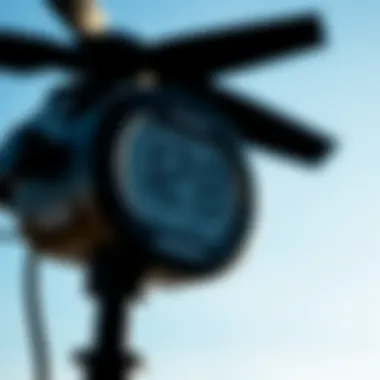
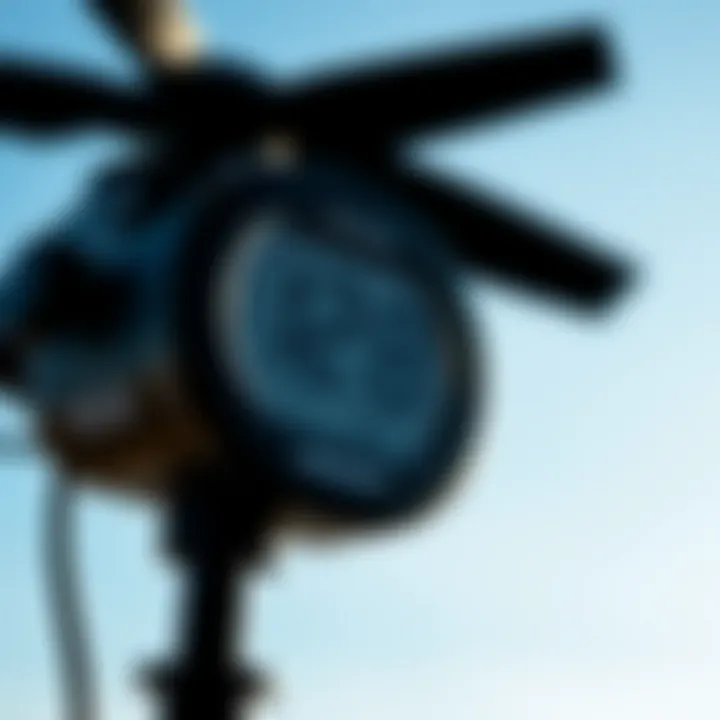
Intro
As kiteboarding continues to gain traction among water sports enthusiasts, the importance of precise wind measurement becomes increasingly apparent. Kiteboarders rely heavily on accurate wind data to inform their choices, whether it’s selecting the right gear, choosing the ideal location, or timing their sessions. This makes understanding the technology behind wireless wind meters not merely a technical curiosity but a crucial element in enhancing the kiteboarding experience.
In this article, we will explore the role of these devices in kiteboarding, discuss their key features, compare them with traditional methods of wind measurement, and delve into how they can significantly influence your sessions on the water. By opening this discussion, kiteboarders of all levels, from novices to seasoned veterans, can gain insights into the tools available to them and make informed decisions about their adventures.
Let’s dive deeper into the world of gear selection, a fundamental aspect of successfully navigating the winds and waters.
Understanding Wireless Wind Meters
When it comes to kiteboarding, understanding the wind is akin to knowing your trading cards in a game of poker—you can't play without a grasp of what you're dealing with. Wireless wind meters play a crucial role in delivering real-time wind data, making them indispensable for enthusiasts and professionals alike. These devices revolutionize how kiteboarders assess conditions, impacting their performance and safety.
By relying on technology that measures wind speed and direction, users gain a tangible advantage on the water. A good wireless wind meter ensures that decisions made during a session are based on current conditions rather than guesswork. Whether picking a spot for launching or adjusting a kite mid-flight, the ability to accurately measure wind helps in adjusting tactics swiftly.
Definition and Functionality
Wireless wind meters, as the name suggests, operate without cumbersome cords, using modern technologies to transmit wind data directly to the user. The primary function of these meters is to measure and relay wind speed and direction, which is essential for the kiteboarding experience. The data gleaned from these devices not only enhances thrill but also informs safety decisions.
Components of Wireless Wind Meters
To appreciate the full value of a wireless wind meter, it is necessary to break down its components and understand how each part contributes to overall functionality.
Anemometer Types
At the very heart of wind measuring devices is the anemometer. There are various types of anemometers, each with its own particular strengths. Most commonly, you’ll encounter cup anemometers, which utilize rotating cups to gauge wind speed. These are often favored for their reliability and simplicity.
Another option is the vane anemometer, which integrates a blade that spins with the wind flow. Generally, vane anemometers are appreciated for their precision and ability to easily determine wind direction.
In a kiteboarding context, a robust cup anemometer might be celebrated for its durability against harsh conditions, while a less durable device could hinder performance due to inaccurate readings. The choice of anemometer is a significant factor for any kiteboarder looking to optimize their sessions.
Sensors and Data Transmission
The sensors within wireless wind meters are vital for accurate measurement. These sensors gauge both wind speed and direction and then communicate this data through wireless signals to a display unit or a mobile device.
The efficiency of data transmission is paramount. High-quality sensors typically support faster sampling rates, providing more responsive readings. This capability enables kiteboarders to adjust their techniques in real-time, improving both safety and enjoyment on the water. However, low-quality sensors may falter in conditions where precision is most needed, potentially leading to misinformed decisions.
Display Units
The display unit serves as the interface between the wind meter and the user. Just as a dashboard communicates vital information to a driver, the display provides real-time readings of wind conditions. Wireless meters often feature backlit displays for easy readability, even in low-light conditions.
The information displayed typically includes wind speed, direction, and sometimes additional metrics like temperature or humidity. A well-designed display unit is characterized by its clarity and ease of use, allowing kiteboarders to read data at a glance, which is essential for making quick decisions. On the other hand, overly complicated displays might lead to confusion, detracting from the otherwise exhilarating kiteboarding experience.
Importance of Accurate Wind Measurement
Accurate wind measurement stands as a cornerstone in the kiteboarding experience, shaping not only performance but also ensuring safety on the water. This aspect is often underappreciated by novices, yet it plays a critical role in refining skills and navigating the unpredictable nature of wind. Understanding the intricacies of wind dynamics can drastically enhance the rider's performance and enjoyment of the sport.
Impact on Kiteboarding Performance
Choosing the Right Equipment
In the realm of kiteboarding, the selection of appropriate gear heavily hinges on wind measurement. When kiteboarders arm themselves with accurate wind data, they can align their equipment choices with the existing conditions—be it a smaller power kite for blowing winds or a larger one when the breeze take a turn. This ensures not only efficiency but also minimizes the chances of mishaps due to ill-matched gear.
One key characteristic of opting for the right equipment is understanding the measurement range that comes with wireless wind meters. It's a beneficial choice, as these devices can provide real-time readings of wind speed and direction, empowering riders to make swift adjustments. For instance, gear designed for higher wind speeds might become less advantageous in lighter conditions. Thus, the unique feature here lies in the adaptability of understanding local wind readings to elevate performance accordingly.
Safety Considerations
When kiteboarding, safety is paramount, and accurate wind measurements directly contribute to a safer riding experience. Riders must assess wind strength and the presence of gusts that could potentially impact their stability. Diligent kiteboarders recognize that keeping an eye on real-time data can prevent accidents, making this a critical aspect of safety.
The key feature of safety considerations is the reliance on precise wind readings to make informed decisions. Following the wind patterns and potential changes can dramatically reduce the risk of uncontrolled kite behavior, which is particularly critical in challenging weather conditions. While this approach requires diligence and a willingness to continuously monitor, the advantages far outweigh any disadvantages, providing a significant boost in confidence on the water.
Wind Patterns and Conditions
Understanding Local Wind Conditions
A solid grasp of local wind conditions significantly benefits kiteboarders by allowing them to predict changes more accurately. Knowledge of local wind patterns, including their tendencies and anomalies, means kiteboarders can anticipate the changes that might arise unexpectedly. For instance, knowing that a lake may experience sudden gusts due to surrounding geographic features allows for better preparation.
This understanding serves as a crucial tool in optimizing kiteboarding sessions. By identifying the reliable trends in wind patterns, kiteboarders can choose their time on the water more wisely, maximizing enjoyment and minimizing risks associated with unpredictable winds.
Seasonal Variations
Wind varies with seasons, and recognizing these fluctuations can be a game changer for kiteboarders. Each season offers different wind characteristics—some are consistent, while others might be gusty or unreliable. Understanding these seasonal variations enables enthusiasts to plan sessions more effectively, ensuring that they hit the water when conditions are just right.
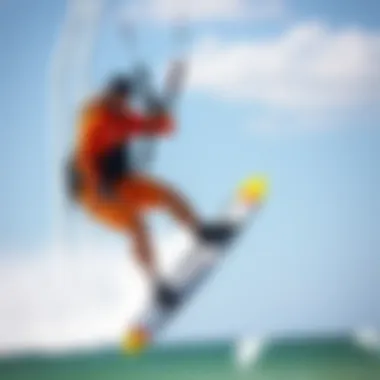
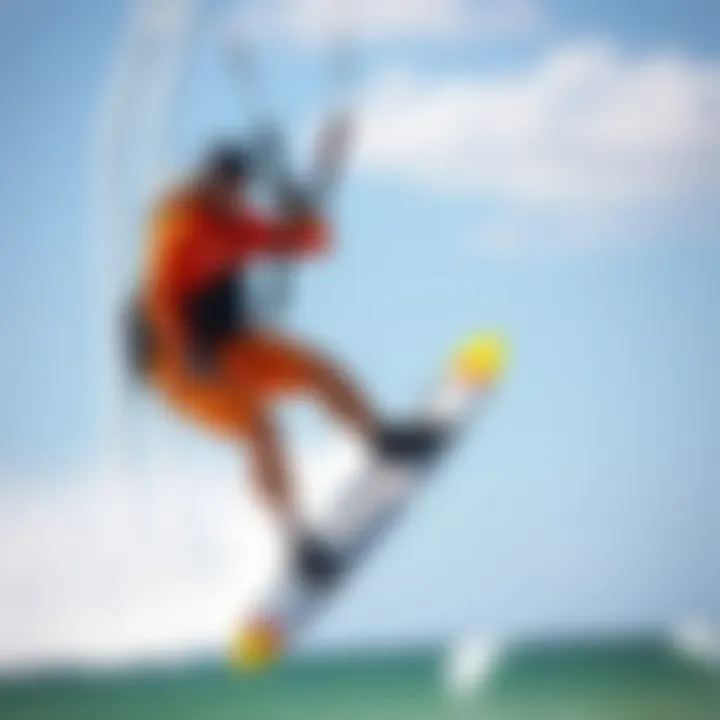
The unique feature of being aware of seasonal wind patterns is that it often leads to an informed decision-making process. For instance, spring winds may produce more reliable conditions than summer blusters laden with unpredictability. This awareness allows kiteboarders to select appropriate sessions or even location adjustments that account for changing patterns throughout the year
Being strategic about when and where you kiteboard is half the battle. By understanding wind patterns and making informed choices, you can elevate your entire kiteboarding experience.
Comparative Analysis: Wireless vs. Traditional Wind Meters
Understanding the nuances between wireless and traditional wind meters is crucial for kiteboarding enthusiasts. The choice between these two types can significantly affect the performance and safety of kiteboarding activities. Each has unique features, advantages, and limitations that can influence a rider's experience on the water.
Advantages of Wireless Technology
Portability and Convenience
Wireless wind meters shine when it comes to portability and convenience. Without the need for physical cables or connections, these devices offer ease of transport. Kiteboarders can simply toss a wireless meter into their gear bag and hit the waves, eliminating the hassle of tangled wires or heavy equipment. This particular aspect caters to the increasingly mobile lifestyle of athletes who might jump from one location to another without worrying about load.
One key characteristic of this portability is the compact design of many wireless models. These are often lightweight and ergonomically designed, fitting comfortably into small pockets or compartments. This makes them particularly a popular choice for those who prefer minimal distractions while preparing for their kiteboarding sessions. However, one has to keep an eye out for battery life, as the convenience of portability sometimes comes with a trade-off in power reliance.
Real-time Data Access
Another standout feature of wireless wind meters is their capability for real-time data access. These devices allow users to see wind data instantaneously on mobile apps or dedicated displays. Riders can make adjustments to their kite setups based on live statistics, allowing them to react promptly to changing conditions. In the world of kiteboarding, where optimal performance relies on precision, having immediate access to wind speeds can mean the difference between a great session and an unsuccessful outing.
The key characteristic of this feature lies in its connectivity options—be it Bluetooth, Wi-Fi, or proprietary connections—that enable seamless integration with smartphones or tablets. The convenience of real-time monitoring serves well for both recreational and competitive kiteboarders. However, it's worth noting that reliance on technology might lead to issues if devices fail or become out of battery at critical moments.
Limitations of Traditional Anemometers
Accuracy Challenges
Turning the lens to traditional anemometers, one significant limitation is the accuracy challenges they often present. While these devices—like cup or vane anemometers—have been the standard for wind measurement for years, they can sometimes produce inconsistencies depending on their location and environmental influences. Kiteboarders need precise data to maintain optimal performance and safety, and any form of measurement error can jeopardize their experience.
A key characteristic of traditional units is that they often require calibration and placement considerations to function properly. Placement near obstacles such as trees or buildings can lead to distorted readings, affecting user trust in the data. While these meters are reliable in certain conditions, achieving consistent accuracy across diverse environments is a challenge, making them less favorable in progressing with kiteboarding technology.
Mobility Restrictions
Additionally, traditional anemometers face mobility restrictions that can hinder a rider's experience. Many of these devices are larger and more cumbersome to transport compared to their wireless counterparts. For someone who likes to chase the wind, lugging around a hefty traditional meter can become a drag. In crowded kitesurfing spots, you may find it awkward to set up equipment just to get an accurate reading.
This characteristic of bulkiness can limit where and how often a kiteboarder is willing to check the wind conditions, reducing the spontaneity that many crave in the sport. Traditional wind meters might also require a power source or specific setup, complicating their use in on-the-go scenarios.
"When kiteboarding, reacting to wind changes swiftly is crucial. Wireless wind meters grant that agility, unlike many traditional models."
Selecting a Wireless Wind Meter for Kiteboarding
Choosing the right wireless wind meter is crucial for kiteboarders who want to maximize their on-water experience. These devices can be the difference between soaring high in the sky or crashing down due to poor wind assessment. Having reliable data on wind conditions helps kiteboarders make informed decisions regarding equipment and timing. But with numerous options on the market, it’s essential to understand what features matter most, ensuring you don’t end up with a gadget that doesn’t meet your needs.
Key Features to Consider
Measurement Range
When talking about Measurement Range, it refers to the spectrum of wind speeds that a device can accurately read, typically expressed in miles per hour or kilometers per hour. For kiteboarding, a broader measurement range is important because conditions can vary greatly, especially if you're at a dynamic spot like a beach or a river delta.
- A wind meter with a range of, say, 5 to 40 mph provides flexibility, allowing you to assess conditions from gentle breezes to stronger winds that are ideal for advanced maneuvers.
- However, one must keep in mind that many budget-friendly options may only offer a limited range, which might not suffice for seasoned kiteboarders. So, it’s wise to look for a model that caters to your specific needs, particularly if you're targeting high-performance days.
Calibration Options
Calibration is the process of adjusting your wind meter to ensure it gives accurate readings. Calibration Options are often overlooked but can be crucial, especially in changing environments.
- Many quality models come with user-friendly calibration options, which means you can ensure accuracy before each session. This is particularly beneficial during seasonal transitions when environmental factors impact readings.
- Keep in mind that while some devices come pre-calibrated, they might not hold accuracy as temperatures or environmental conditions change. Consequently, being able to easily recalibrate can be a significant advantage.
Battery Life
Battery Life is the unsung hero of any wireless device. For those spending hours on the water, a reliable wind meter needs to last through your session without that little "low battery" warning ruining your fun.
- Devices that offer long battery life—generally around 20 to 30 hours—ensure you won’t have to worry about charging your gear frequently. This is especially handy during weekend trips or competitions where you might be out all day.
- However, not all long-lasting batteries provide accurate readings consistently. It’s essential to investigate how a meter performs in terms of longevity alongside accuracy to find a sweet spot for your preferences.
Brand Recommendations
Top Manufacturers
When it comes to Top Manufacturers, certain names stand out in the realm of wireless wind meters; companies like Kestrel, WeatherFlow, and Vaavud have really made their mark. These brands are known for producing reliable devices that combine functionality with durability.
- Not only do these manufacturers provide a range of options tailored for kiteboarding, but they also offer impressive customer support and warranty options, which can set your mind at ease.
- Moreover, their devices often come with advanced features like smartphone connectivity or integrated GPS for added value on the water.
User Feedback Analysis
Lastly, User Feedback Analysis serves as a powerful tool in selecting the right wind meter. When potential buyers take time to dissect user reviews, they often uncover beneficial insights that specs alone can’t provide.
- Reviews can reveal hidden gems about user experience, such as whether the product is as waterproof as claimed or how well it holds up in harsh conditions.
- This feedback process can also highlight common issues with certain devices, allowing you to steer clear of products that might have more downsides than upsides. Checking platforms like Reddit or dedicated kiteboarding forums can provide invaluable information from real users.
In summary, selecting the right wireless wind meter involves a mix of understanding key features like measurement range, calibration, and battery life alongside brand reputation and user reviews. The right device not only provides accurate wind readings but also enhances safety and decision-making on the water.
Practical Applications of Wireless Wind Meters in Kiteboarding


In the fast-paced world of kiteboarding, understanding wind conditions is not just a navigational nuance—it's a deciding factor between a thrilling ride and a potential mishap. Wireless wind meters are indispensable for kiteboarders, offering a glimpse into real-time wind dynamics that can shape the kiteboarding experience. Understanding their practical applications reveals not only their functionality but also their contribution to safety and performance on the water.
Pre-launch Assessment
Gathering Wind Data
Gathering accurate wind data is the cornerstone of pre-launch assessments and is critical for kiteboarders. Before making the leap into the water, having reliable wind readings allows enthusiasts to gauge whether conditions are suitable. The hallmark of gathering wind data is precision. With a wireless wind meter, one can access instantaneous wind speed and direction, critical metrics that inform decision-making.
Advantages of precise data gathering include:
- Timeliness: Real-time information can mean the difference between a smooth ride or a whirlwind of unexpected challenges.
- Clarity: Understanding wind patterns can help in adaptations from one riding style to another, aligning the gear with changing conditions.
That said, there are some considerations. Environmental obstructions—like tall buildings or trees—can throw off readings, leaving kiteboarders with skewed information. Therefore, the choice of location for data collection becomes paramount.
Adjusting Kites Accordingly
After gathering wind data, the next logical step is adjusting kites to fit the current conditions. This process is integral. Kiteboarders rely on wind specifics to select the right kite size and adjust its trim settings. Highlighting this adaptive response is crucial; kiteboarding is a dynamic sport where conditions can shift faster than a New York minute.
The unique feature of this adjustment lies in:
- Responsiveness: Quick reactions to data inputs allow kiteboarders to maximize their experience right from the off.
- Customization: Fine-tuning gear based on real-time conditions offers tailored riding experiences, which can enhance performance and enjoyment.
However, adjusting kites is not without challenges. Misreading data or failing to adjust promptly can lead to overpowered or underpowered kites, resulting in compromised safety. Therefore, the ability to interpret data is just as significant as the data itself.
On-water Usage
Monitoring Real-time Wind Changes
Once on the water, the dynamics of wind can change in an instant. Monitoring these changes in real-time is vital, as kiteboarders can adapt their approach to varying wind conditions. This ongoing awareness helps mitigate risks associated with sudden gusts or lulls. The ability to monitor wind changes while riding proves to be an ace up one’s sleeve.
Key aspects include:
- Flexibility: Adjusting techniques as wind conditions fluctuate can significantly improve performance.
- Safety: Awareness of changing winds promotes timely reactions, reducing the risk of accidents.
This sort of capability can sometimes feel like having eyes in the back of one’s head, providing peace of mind. However, distractions on the water can lead to overlooking critical data changes, emphasizing the importance of vigilance.
Improving Decision-making
Improving decision-making while kiteboarding is what separates the novices from the experts. Having real-time data at one’s fingertips fosters an environment where informed choices can be made quickly. Decisions about when to ride, how to adjust, or even whether to abort the launch can weigh heavily on available information. It’s a delicate juggling act between instinct and data-backed strategy.
Reasons for emphasizing decision-making include:
- Confidence: With reliable data, kiteboarders can make bolder choices without feeling like they are flying blind.
- Enhanced Performance: Making informed decisions allows for optimizing each ride, allowing kiteboarding enthusiasts to harness wind currents
That being said, an overreliance on technology can occasionally backfire. A misplaced focus on data might overshadow intuitive skills developed over time, leading to a disconnect from the essence of the sport. Balancing intuition with factual wisdom makes for a better approach.
"In kiteboarding, knowing the wind isn’t everything; it’s about reading its language and responding accordingly."
As kiteboarding continues to evolve, practical applications of wireless wind meters promise to become increasingly significant. They grant unprecedented access to the very essence of the sport—wind dynamics. By using this data effectively, kiteboarders stand to enhance not just their rides but their entire experience on the water.
Integrating Wireless Wind Meters with Other Technologies
The integration of wireless wind meters with other technological devices signifies a transformative era for kiteboarding enthusiasts. Combining the capabilities of wind meters with mobile applications and GPS systems not only enhances the user experience but also maximizes performance and safety on the water. With real-time data at their fingertips, kiteboarders can make swift decisions that are pivotal to their enjoyment and safety.
Mobile Apps and Connectivity
Data Sharing with Fellow Riders
Sharing wind data among kiteboarders can truly revolutionize the way they interact on the water. The key characteristic of data sharing is its ability to create collaborative learning and strategy among riders. This tactic allows enthusiasts to compare wind conditions in real time, thus facilitating better decision-making that can lead to improved performance. In a sport where conditions can change as quickly as a flick of a switch, having access to collective data can be a significant advantage.
- Unique Features: Many mobile apps allow users not only to share their wind data but also to visualize it on maps, displaying real-time conditions at different spots.
- Advantages: The main advantage here is the community aspect—riders can support each other, offering insights based on their own experiences. However, one disadvantage is the potential for misinformation. If users are not cautious, data inaccuracies can lead to poor decisions.
Custom Alerts and Notifications
The advent of custom alerts and notifications has added another layer of adaptability. Custom alerts empower riders to set parameters that matter most, like wind speed thresholds or changes in conditions. This user-driven feature is becoming increasingly popular because it allows individuals to focus on what matters without tirelessly checking the wind meter.
- Unique Features: Users can receive immediate push notifications if conditions drop outside their personal safety range, helping them to maintain a vigilant watch over their riding environment.
- Advantages and Disadvantages: While custom alerts can indeed enhance safety and awareness, they can also be a double-edged sword. Over-reliance on alerts might cause riders to be distracted or ignore their instincts, possibly leading to regrettable choices.
Linking Wind Meters with GPS Systems
Enhanced Tracking
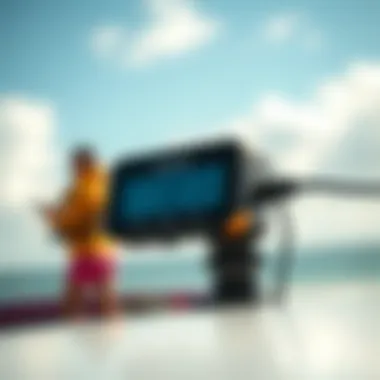
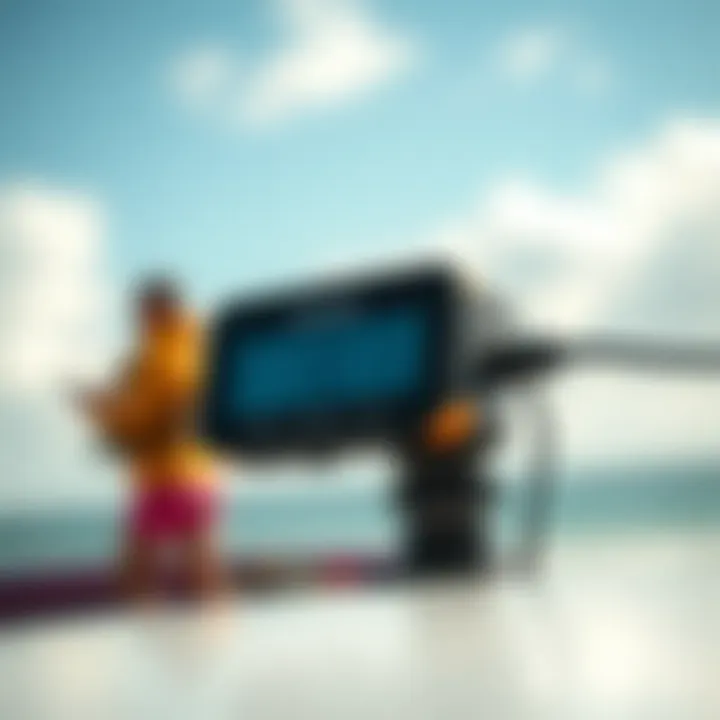
When integrated with GPS systems, wireless wind meters can vastly improve tracking capabilities for kiteboarders. The key feature to highlight is the ability to create precise geographic records of sessions. This includes mapping out wind patterns experienced during specific times and locations, providing invaluable information for future outings. Knowing where the best winds are likely to be can transform a decent session into an extraordinary one.
- Unique Features: Some systems even offer predictive capabilities, analyzing past wind data for forecasting future conditions.
- Advantages and Disadvantages: Enhanced tracking undoubtedly offers benefits such as improved planning and knowledge of local wind patterns. However, tech overload can also cause distractions; users may become so engrossed in their devices that they miss crucial environmental cues.
Safety Features
Within the realm of kiteboarding, safety is paramount. When wind meters collaborate with GPS technology, they can incorporate safety features designed to keep riders out of harm's way. This includes emergency transmissions or location tracking in distress situations, which adds an extra layer of security.
- Key Characteristics: These safety features allow real-time location sharing with trusted contacts, ensuring that someone is always aware of your whereabouts on the water.
- Unique Features: Some advanced systems even offer geo-fencing capabilities, alerting users if they drift into potentially dangerous areas.
- Advantages and Disadvantages: While these features can significantly enhance safety, they may also make riders complacent. Relying too heavily on technology might lull them into a false sense of security, leading to lapses in their innate caution.
Challenges and Considerations
When using wireless wind meters, it's crucial to understand the various challenges and considerations that can impact their effectiveness and reliability. By examining factors that may affect measurements or user interactions with these devices, kiteboarders—not to mention instructors and event organizers—can make more informed decisions. This section delves into some key elements that need careful consideration.
Environmental Influences
Obstructions to Wind Flow
Much like how a boulder can divert a river's course, obstructions to wind flow can significantly impact the accuracy of wind readings. These obstructions might be anything from buildings to trees, anything that can disrupt the natural flow of air. Such factors can create turbulent wind patterns that confuse both the meter and the user. For kiteboarders, having a precise understanding of wind conditions is vital; being misled by inflated numbers can lead to poor decisions on the water.
One key characteristic of these obstructions is their unpredictable nature. The wind's movement is often erratic around such barriers. This variability can lead to misinterpretations of data. For example, kiteboarders relying on measurements from a meter located near a tree may find that their actual experience on the water diverges from predicted wind speeds. Therefore, placing the wind meter in an open area away from obstructions can yield far more reliable results. This is why it’s not uncommon for seasoned riders to scout locations carefully before setting up their equipment.
Natural Factors Impacting Measurements
The natural environment contributes additional layers of complexity when measuring wind conditions—these include temperature, humidity, and even atmospheric pressure. Each of these elements can affect how wind is perceived and how anemometers register it. For instance, high humidity levels often lead to denser air, which can modify the results on a wind meter. In essence, what you see on the screen may not always tell the full story; it's vital for users to understand the nuances of these natural factors.
A key feature of this area is the variability in readings depending on geographical features. There might be significant deviations in wind speed and direction caused by hills or valleys. Consequently, kiteboarders might experience a drastic shift even when moving only a few meters horizontally. Understanding these factors allows enthusiasts and instructors to communicate better and set clear expectations for riders, improving overall safety and enjoyment during kiteboarding sessions.
User Error and Setup
Calibration Issues
Calibration issues can pose a significant barrier to effective wind measurement. Simply put, if a meter isn’t calibrated correctly, you could be chasing your tail trying to figure out why readings seem off. Many users overlook this critical aspect, assuming the device will work perfectly out of the box. However, as they soon find out, improper calibration can lead to skewed data, affecting performance and safety.
The importance of calibration cannot be overstated. Consider this: a kiteboarder sets up their meter without checking its calibration after several months of use. The results they see could be drastically misleading. It’s essential for users to regularly check and recalibrate their devices to ensure accuracy. Getting into the habit can aid significantly when launching, as it sets a solid foundation for reliable data.
Improper Placement
Just as the choice of a launch spot can make or break a kiteboarding experience, the placement of the wind meter can determine how accurate the readings are. Placing the meter too close to the ground or near structures influences the data captured, often resulting in misleading statistics.
Proper placement is all about accessing clean, unobstructed air. For instance, if a rider sets up their wind meter right next to a dock or boat ramp, it may not provide reliable readings due to turbulent air created by nearby activity. Instead, placing the meter in a clear area away from obstacles not only enhances measurement reliability but also contributes to a safer and more informed riding experience.
Through these considerations, every participant in the kiteboarding community—from instructors to adventurers—can benefit from a deeper understanding of the elements affecting their wind measurements.
"Knowledge paves the way for a smoother ride; the right information helps us steer clear of the winds that could steer us wrong."
By recognizing these challenges, the kiteboarding community can equip themselves with the necessary insights to navigate the waters wisely.
Future Trends in Wind Measurement Technology
As the kiteboarding world evolves, so do the tools that riders depend on to maximize their experience on the water. The future of wind measurement technology holds great promise, with advancements primarily driven by the need for accuracy, adaptability, and comprehensive data analysis. These trends not only enhance the thrill of kiteboarding but also reinforce safety measures and informed choices.
Advancements in Sensor Technology
The heart of any wind meter is its sensor technology. New sensors are being developed that are more sensitive and accurate, capable of capturing real-time wind conditions with remarkable precision. Such advancements include miniaturization of sensors, making them lighter and more portable without compromising performance.
Furthermore, modern sensors can measure wind speed and direction more reliably by utilizing various technologies like ultrasound and laser systems. This means kiteboarders can expect more trustworthy information, allowing them to gauge conditions better than ever before.
Potential for Integration with Other Weather Instruments
Comprehensive Weather Insights
The integration of wireless wind meters with other meteorological instruments offers substantial benefits. This allows for a holistic view of environmental conditions which greatly assists kiteboarders. For instance, a wind meter that connects seamlessly with barometers, rain gauges, and even temperature sensors can provide data that is not just about wind, but a complete weather snapshot.
These comprehensive insights help riders anticipate changes in conditions, enhancing their overall experience and safety on the water. One key characteristic of these integrative systems is their ability to process and display data in formats that are easy to understand, making it accessible even for those not well-versed in meteorology.
It’s worth noting that while this integration presents numerous advantages, the reliance on multifaceted systems can lead to a steeper learning curve. Riders may need to familiarize themselves with multiple data points to fully benefit from such systems.
"Understanding holistic weather conditions can be the difference between a thrilling day on the water and an unexpectedly dangerous one."
Cross-disciplinary Applications
Additionally, the potential for cross-disciplinary applications of wind measurement technology is noteworthy. By linking wind meters with systems used in agriculture, forestry, and urban planning, kiteboarders can receive insights that are relevant not just for their sport, but for broader environmental trends.
For example, wind data might become essential in managing crop growth or urban heat and air quality, informing kiteboarders of potential changes in the landscape that could affect their hobby. The collaborative use of data from various fields makes for a rich repository of information that benefits not only kiteboarders but also professionals in these other domains.
However, one must tread carefully. The complexities involved in integrating disparate systems can present challenges. Ensuring data compatibility and accuracy across various devices can require substantial effort and resources.
In summary, the future of wind measurement technology looks promising, with advances in sensors and integrative systems poised to offer kiteboarders unprecedented access to accurate and comprehensive data. As the technology continues to evolve, it will spur a deeper understanding of not only wind conditions but also their wider implications on the environment and sports.















